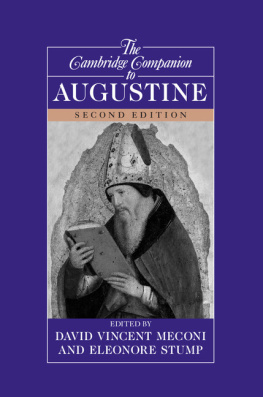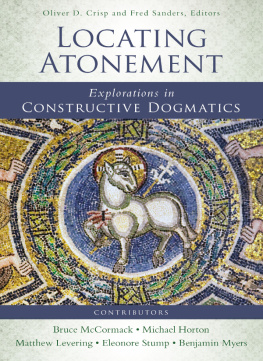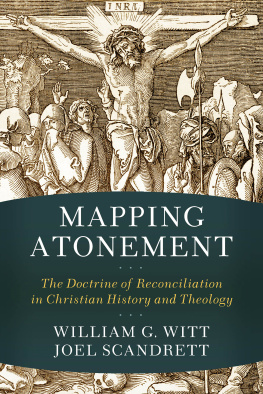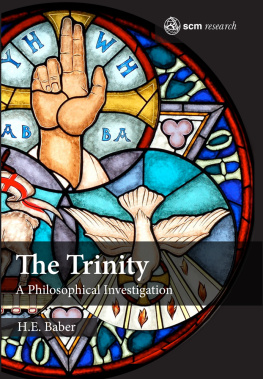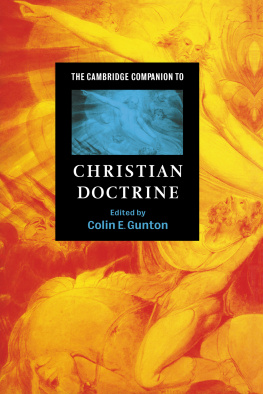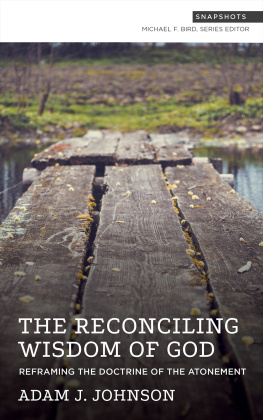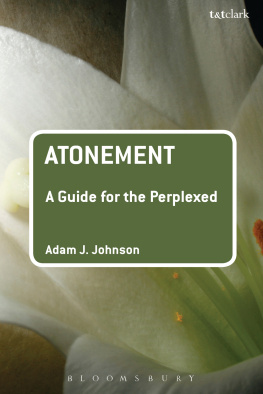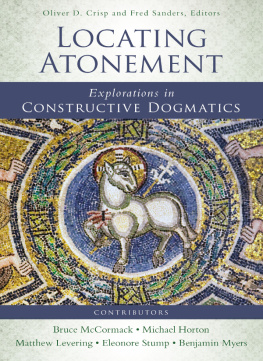Analytic Theology utilizes the tools and methods of contemporary analytic philosophy for the purposes of constructive Christian theology, paying attention to the Christian tradition and development of doctrine. This innovative series of studies showcases high-quality, cutting-edge research in this area, in monographs and symposia.
Kevin W. Hector
R. T. Mullins
Atonement
Eleonore Stump


Great Clarendon Street, Oxford, OX2 6DP, United Kingdom
Oxford University Press is a department of the University of Oxford. It furthers the Universitys objective of excellence in research, scholarship, and education by publishing worldwide. Oxford is a registered trade mark of Oxford University Press in the UK and in certain other countries
Eleonore Stump 2018
The moral rights of the author have been asserted
First Edition published in 2018
Impression: 1
All rights reserved. No part of this publication may be reproduced, stored in a retrieval system, or transmitted, in any form or by any means, without the prior permission in writing of Oxford University Press, or as expressly permitted by law, by licence or under terms agreed with the appropriate reprographics rights organization. Enquiries concerning reproduction outside the scope of the above should be sent to the Rights Department, Oxford University Press, at the address above
You must not circulate this work in any other form and you must impose this same condition on any acquirer
Published in the United States of America by Oxford University Press 198 Madison Avenue, New York, NY 10016, United States of America
British Library Cataloguing in Publication Data
Data available
Library of Congress Control Number: 2018935713
ISBN 9780198813866
ebook ISBN 9780192543417
Printed and bound by CPI Group (UK) Ltd, Croydon, CR0 4YY
Links to third party websites are provided by Oxford in good faith and for information only. Oxford disclaims any responsibility for the materials contained in any third party website referenced in this work.
For John
ut ardeat cor meum
in amando Christum Deum
(Stabat Mater)
My life flows on in endless song
Above earths lamentation.
I hear the real though far-off hymn
That hails a new creation.
Above the tumult and the strife,
I hear its music ringing.
It sounds an echo in my soul
How can I keep from singing?
What though the tempest loudly roar,
I know the truth: it liveth.
What though the darkness round me close,
Songs in the night it giveth.
No storm can shake my inmost calm,
As to that rock Im clinging.
While love is lord of heaven and earth,
How can I keep from singing?
When tyrants tremble sick with fear
To hear their death knells ringing,
When friends rejoice, both far and near,
How can I keep from singing?
In prison cell and dungeon vile,
Our hearts to them are winging.
When friends by shame are undefiled,
How can I keep from singing?
Foreword
To commend this new work on the atonement by Eleonore Stump, I think it is helpful to introduce a parable, the resolution of which sums up her extraordinary achievement.
In the story of The Snow Queen by Hans Christian Andersen a little boy called Kai has caught splinters in his eyes and in his heart. These splinters distort his perception and desires so that he admires only mathematical perfection and boasts of his rational knowledge. In this evil mood, the Snow Queen takes him to her palace. Here he is left alone on a frozen lake, trying to form the word eternity from blocks of ice, without which he can never leave.
Whatever other interpretations may be found, the trap into which Kai falls in The Snow Queen serves as a warning about the care needed in applying analytic methods to reach eternal truths. The warning is that the clear and precise analyses of concepts that have been orphaned from the living realities from which they are drawn risk generating frozen representations, incapable of grasping those realities and chilling the mind and heart.
The danger to which The Snow Queen draws attention has been especially severe for the Christian understanding of the atonement, or what Stump calls in the at onementthe making one with God achieved through the passion and death of Christ. On the basis of other Christian claims about God, notably that God is love (1 John 4:8) and desires all persons to be saved (1 Tim. 2:4), the atonement is or ought to be an act of supreme love, with love as its means and its goal. Yet without great care the notion of the repayment of a debt, arguably the most influential metaphor of the atonement, freezes out love. On such a view, Christ, in his assumed human nature, endured the penalty or paid the price in suffering which would otherwise have had to be exacted from all sinful human beings to balance the scales of divine justice.
Some of the problems with this approach have long been recognized but Stump throws them into stark relief. In particular, she argues that this Anselmian interpretation, with its implicit mechanistic metaphor of balancing scales, does not in fact solve the problem of separation from God. Accounts based on such principles in fact make this problem worse from the point of view of the at onement. Instead of divine love, the dominant image of God also risks becoming that of an implacable, merciless, or even sadistic debt-collector. Like Kai in the story of The Snow Queen, the doctrine of the atonement then turns cold, the chilling effect of which has tended to permeate, for many people, through the reception of the entirety of Christian revelation.
As Stump explains, the main alternative strand of the Christian tradition has been to treat the chief obstacle to union with God as lying in something lacking in human beings that prevents them being united in friendship with God. This Thomistic interpretation has focused on the healing of human disorders through the infusion and cultivation of the virtues and gifts of the Holy Spirit in the life of grace. The implicit metaphor is organic rather than mechanistic and, in many ways, this approach is more promising than the Anselmian interpretation. But this solution does not wholly explain how these divine gifts heal all the impediments to the ruptured relationship with God. And if God can give the Holy Spirit to anyone, why was the Christs passion and death necessary? The connection with the Holy Spirit is stated in Scripture (John 16:7), but without an explanation, Christs passion and death can seem gratuitous.
Stump presents a radical alternative, the root metaphor of which is neither mechanistic nor organic but adopts the relationship of persons as its central theme. More precisely, the root metaphor is second-person relationship, the stance that I take to you and you take to me that is irreducible to an impersonal world of objects, or even isolated living and growing things. The fruition of second-person relationship is love, which Stump describes as two interconnected desires that are blocked by the consequences of sin: the desire for the good of the beloved, which is blocked by guilt; and the desire for union with the beloved, which is blocked by shame. Since the goal of the atonement is divine friendship with God that begins in this life and is glorified in eternity, any plausible account of this atonement therefore has to answer two key questions. How do we deal with human guilt? How do we deal with human shame?


